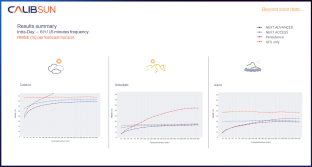Probabilistic forecasting methods
 3 May 2023
3 May 2023
 3 May 2023
3 May 2023
Traditional deterministic methods have long been used to make spot estimates, providing a single prediction without quantifying the inherent uncertainty. However, with the growing recognition of uncertainty in complex systems, probabilistic approaches have gained in importance. This article explores the importance of solar resource forecasting methods based on a probabilistic approach, and its advantages for uncertainty-aware decision-making.
Unlike deterministic methods, which give a single result, probabilistic approaches provide a range of possible outcomes with associated probabilities. These methods take into account the uncertainty inherent in the various factors influencing forecasts, such as data variability. By taking into account the full range of possible outcomes, probabilistic approaches enable a more complete understanding of the system under study. They explicitly recognize and quantify uncertainty by providing a range of possible outcomes and their associated probabilities.
As PV production is highly variable, subject as it is to the vagaries of the weather, operators, traders and grid managers need to be able to anticipate production capacity, assess risks and envisage scenarios in order to make the best decisions. With forecasting data based on a probabilistic approach, solar players can build solid strategies, better adapted to the market (trading, balancing, storage...) and limit risk-taking.
What's more, the probabilistic approach is more flexible and better suited to forecasting solar resources. It enables new data and information to be integrated as and when it becomes available, to provide up-to-date forecasting information.
AI for probabilistic approaches
Thanks to artificial intelligence and the availability of meteorological data (Numerical Weather Prediction, satellite images, terrestrial sensors, etc.), probabilistic approaches will play an increasingly important role in solar resource forecasting. This will enable solar players to optimize the operational and financial management of photovoltaic power plants, and increase the share of PV in the energy mix.


 en
en 
 fr
fr es
es de
de



